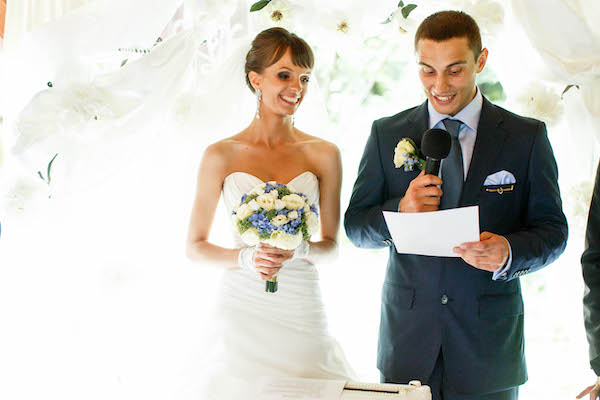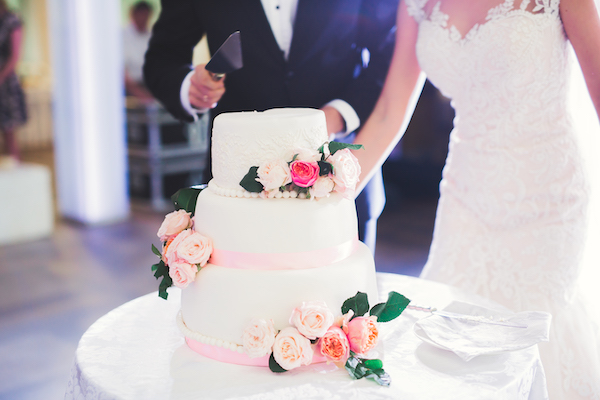There’s more to a reception than “dinner and dancing to follow”–and while the reception is a festive celebration, there are also essential elements that make them meaningful and memorable.
Your wedding day is going to fly by, and often, brides say they regret running out of time, running late, or forgetting to include important details. And thinking through the details of your reception will ensure that your guests have a wonderful experience, too. So get ready to scroll and screenshot parts of this article–you’ll need it when you work on your wedding reception timeline!
How Long Should Your Wedding Last?
Most brides don’t want the night to end, but in reality, your guests will be ready to head home around the 6 hour mark. So if your ceremony begins at 4 pm, aim to wrap things up by 9:30 or 10 pm. This is especially important if you envision lots of guests sticking around for a grand exit!
Essential Reception Elements
Let’s assume that your ceremony lasts about an hour, and that guests won’t have to travel very far to get to the reception location (if it’s all at the same place, even better!) That gives you around 4.5-5 hours for your cocktail hour and reception. Here’s everything you’ll want to factor into your reception timeline, and as you’ll see, you’ll still have plenty of time for dancing and fun:

1. Cocktail Hour (1 hour)
Cocktail hour is a highlight for many guests, with couples leaning into trends like signature cocktails, fun entertainment, and games. Yet even with these fun additions, cocktail hour shouldn’t last more than one hour. Your guests will be ready to move into the reception space, enjoy their meals, and hit the dance floor!
2. Seating Guests (5-10 minutes)
Moving guests from cocktail hour to their seats takes time (something many couples forget to take into account). Display escort cards or signage in an area that guests can easily access during cocktail hour to avoid a line. If you are choosing to use a sign, alphabetize the guests’ names instead of grouping by table to make the process even faster.
3. Introductions (depending on your bridal party size: 5-10 minutes)
This process can take longer than you think, especially if lots of people are involved. Make sure your bridal party and your parents know the plan so that lining up doesn’t take too long, and most importantly, ensure that everyone knows where to go once they’re announced.
If this all sounds chaotic, feel free to pare it down. Many couples are choosing to forego bridal party entrances, and ask the emcee to simply introduce their parents before their grand entrance. Others are skipping the grand entrance altogether. No matter what, make a plan and communicate it to your bridal party, parents, and the emcee/DJ/band leader.

4. Speeches (25-35 minutes)
Who speaks is totally up to you, but here’s the traditional order:
- Father of the bride welcomes guests, as he is the traditional host of the evening
- Blessing of the meal (often performed by the officiant or another family member or friend)
- Maid of honor
- Best Man
- Bride and Groom, together or separately
The maid of honor and best man speeches may occur while guests are eating dinner, and the couples’ speech is a nice segue into dancing.
Of course, you may invite additional family and friends to speak. Just be sure to account for the time it will take–and accept that more speeches may equal less time for guests to converse and dance.
If you’d prefer, you could move all speeches to the rehearsal dinner. But personally, I love this part of the reception. Even when I don’t know the couple well, hearing heartfelt speeches from their closest family and friends is touching and memorable.
5. Dances (10-15 minutes)
The couple’s first dance can be held immediately after their entrance, or immediately following dinner, before anyone else takes the floor.
Traditionally, the father of the bride and mother of the groom would also share a dance with their child. Asking guests to stand around the dance floor and watch the parent dances can quickly become tiresome, unless these dances are kept very short. In most cases, I’m in favor of guests being seated, and better yet, eating, while the parent dances take place! This can occur right after the entrances and bride and groom’s dance, or toward the end of dinner.

6. Dinner Service (45 minutes-1 hour)
As mentioned earlier, dinner service may overlap with speeches and/or the special dances. If buffet lines or stations are involved, stacking dinner with other events won’t be possible until every guest has moved through the line.
7. Greeting Your Guests (20-30 minutes)
If dinner is being served, ask that your meals arrive first. Once you’re done eating, you can begin circulating the room to greet your guests. Seat your most senior/important guests (aunts, uncles, your boss, those who traveled a great distance, etc.) at tables closest to you so that you make sure to visit their tables first. If those are the only tables you have time to visit, you’re sure to see everyone else on the dance floor!
If you will have a buffet, some couples opt to dismiss each table to the buffet line. As long as you can do this quickly, I much prefer this to announcements.
8. Dancing (1-2 hours)
Depending on how much you’re able to accomplish during dinner (speeches, special dances, and greeting guests) you should end up with around an hour and a half for dancing. If that doesn’t seem like much, trust me–it is! Even with the best band or DJ, guests can’t physically dance for much longer, and if you want them to stick around for the exit, it’s important not to let this part drag on.

9. Cake Cutting (5 minutes)
The cake cutting can serve as a nice “break” halfway into the dancing portion of the evening. You may be tempted to skip this part of the wedding reception, but it is the signal that all the “programming” of the reception is done, and it’s when many older guests choose to leave.
Be sure to discuss expectations with your partner. There is nothing more awkward than an unwanted cake smash!
10. Bouquet Toss/Garter Toss (5 minutes)
This is another reception element that often takes place in the midst of the dancing portion of the evening. Many couples choose to skip these rituals, and I fully support it! Tossing the tosses will save your single friends some embarrassment, and it will allow for more time dancing. Just be sure to communicate your wishes with your band/DJ.
11. Exit (10 minutes)
Like guests finding their seats, getting everyone outside for an exit can take longer than you think. Guests will need to gather their belongings, pick up their favors, visit the restroom, and be handed sparklers, flower petals, bubbles, etc. Your photographer will also need to get into place for this big moment!
If you’re choosing to skip the grand exit, that’s ok too. Guests can simply trickle out of the reception area when they’re ready!

Let’s Put it All Together:
Here’s a sample of how all of these elements could fit into a timeline:
4 pm-5 pm: Ceremony
5:30-6:30: Cocktail Hour (begin ushering guests into reception room at 6:20)
6:35: Introduction of Bride and Groom and First Dance
6:40-6:50: Welcome Toast by Father of the Bride, blessing by the officiant
6:55: Begin Dinner Service (Bride and Groom Greet Guests)
Toward End of Dinner: Toasts by Best Man, Maid of Honor, and Groom *request staff not clear dishes during the toasts*
7:45: Father-Daughter/Mother-Son Dances; open up dance floor
8:30: Cake Cutting, bouquet and garter toss
9:30: Last Dance, move guests outside for exit and distribute flower petals, bubbles, sparklers, etc.
9:45: Exit
Here’s to dinner, dancing, and so much more!
May your wedding reception be filled with love and laughter! If you’re looking for more tips on etiquette, gift giving, and celebrating in style, be sure to subscribe to the RegistryFinder GiveIt blog for weekly posts on wedding etiquette, bridal showers, wedding trends, and of course, wedding registry guidelines and tips! And as always, be sure to refer your guests to RegistryFinder.com, where they can conveniently locate all of your registries in one place!

